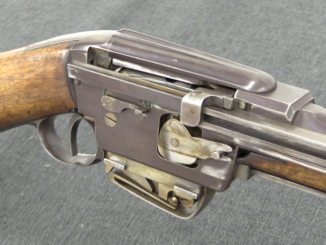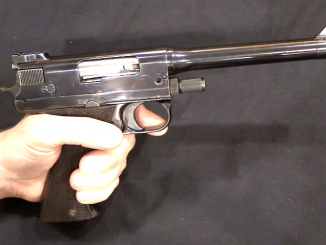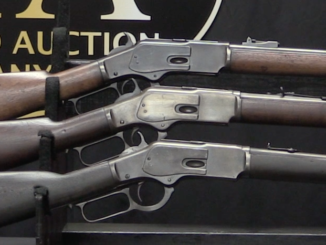Today I am testing out a new .30-06 Chauchat magazine converted from a Johnson M1941 machine gun magazine. The workmanship on this new mag is excellent, and much more extensive than I had initially realized would be necessary. This had the side effect of also making is a very expensive magazine to have made properly.
Unfortunately, the cost of that project has become unjustifiable. I initially wanted to have 5 or 6 of these, to allow me to have about 100 rounds loaded into magazines for competition use. Instead, I will be using a French 8mm Chauchat for anything requiring more than 10-20 rounds of ammunition, and leave this gun for more historical uses. While 8mm Lebel ammunition is expensive as well, I have a substantial number of good military magazines for it, as well as a much more accessible market of spare parts should anything break.
I know a bunch of people will ask about 3D printing magazines. The reason that is not practical is because all of the clearances in the gun were designed around a magazine made of thin metal. In order for a 3D printed plastic to be strong enough to withstand the force of a stack of ammunition under sufficient pressure to feed reliably, the plastic would need to be substantially thicker than the original steel design. And there is not physical space inside the gun for that – the clearances between the bolt head, magazine feed lips, cartridge pusher, and barrel extension don’t allow it.




Metal 3D printing is a thing. I wouldn’t dismiss it so quickly
Hold on a minute! There are too many politicians who would call you out for “homemade terrorist weapons.” And let’s be honest, 3D printers and their infrastructure are more expensive than traditional machine tool kits!
Agreed.
And our PBI was stuck with that monstrosity! The Lewis gun may have been a little heavier, but the bugger dd work!
Okay, let’s back up a bit. You’re comparing apples to oranges. The Lewis gun was intended for TEMPORARY STATIC DEFENSE, not SMASH, BASH, AND SHOOT THEIR BALLS OFF. I haven’t read any accounts of British or American troops spraying down German trenches while literally ON THE SPRINT. Changing pan magazines is a fiddly two-man job and makes you a very good target (for field guns) if you’re standing up and using the Lewis as a machine rifle. I would rather recommend a Hotchkiss light machine gun perhaps if it were given a wooden hand guard and if it were modified to feed from detachable magazines as opposed to feed strips. Of course, I am assuming that the Browning Automatic Rifles have not arrived yet.
Did I mess up?
“Lewis”
Nonetheless there existed A Device for the Lewis Gun Allowing It to be Fired from the Shoulder with Ease., see image here: https://www.ibiblio.org/hyperwar/USN/ref/MG/I/MG-4.html#2
“While 8mm Lebel ammunition is expensive as well, I have a substantial number of good military magazines for it, as well as a much more accessible market of spare parts should anything break.”
Is 7.65×53mm cartridge (known in U.S. as 7.65 mm ARGENTINE MAUSER) available at U.S. market? If yes, then Belgian version of Chauchat firing that cartridge: http://www.historicalfirearms.info/post/166619060194/the-belgian-chauchat-throughout-the-first-world
should be very sought after, but sadly also being rare. Are there any known existing examples?
Ian. 3-d metal not plastic. A lot of difference.
What was the cost on the modded Johnson mag? Also you could look to having a sheet metal worker look into making mags for it, instead of a gunsmith. Most gunsmith I know of work well with milling steel and not working with bending sheet steel.
Thin plastic sheet (non) metal 3D printed magazines would work no better (and likely MUCH worse) than original century-old-already-wonky examples of veteran magazines.
There’s a reason certain items…you know what those in your own experience might be…are made of metal…
If you need to negotiate with a sword, best be done with other than a polypropylene NERF one.
(Homework for 3D printer aficionados: Explore the doubtful relationship between “THERMOplastic” and “FIREarms” and reason out why this not be the best idea. Duh.)
“There’s a reason certain items…you know what those in your own experience might be…are made of metal…”
Magazines were generally steel, but then maybe some other metal (which is not steel) might be used instead? Possibly easier to machine? Any ideas?
Thinking on the adapted Johnson mags again and remembering the follower was designed to push all the way out of the magazine and part-way into the mag-well (as well as designed to supply sufficient spring pressure to allow for 25 rounds total, after topping of 5 through the breech, but likely 21 or 22 rounds possible in the static mag itself … nominally 20 if using 5-round stripper clips to load it)
Wouldn’t it be possible to go about converting the mag in a different way, like applying an adapter sleeve/extension to the top of it that allows the follower to travel through it. (something made out of thinner sheet metal that allows it to fit into the Chauchat mag well)
That or maybe even a plug-in adapter to allow standard johnson mags to be plugged into it.
Given the length of such an adapter, the Johnson follower might not have enough spring length to reach that far, so a modified spring, shortened floor plate, or just some dummy rounds could be added to make up the difference. (the latter much like some snail drum magazines)
It’d be too long to use prone with the standard bipod, but fine to use with the bipod supported on a dirt embankment or off-hand.
Plus, it’d be possible to leave those Johnson magazines intact to use on Johnson LMGs … or possibly some of those rare auto-carbines with the LMG mag well installed. (also maybe some semi-auto Johnson LMGs if any were converted to such prior to the revised NFA legislation that required receivers to have never been full-auto in the first place: weren’t older semi-auto conversions grandfathered into that along with older open-bolt semi-autos? … plus the Johnson is closed-bolt semi auto already)
As far as semi-auto LMG conversions go, the Johnson seems like it’d be among the more fun ones, unless the recoil is as nasty as the Dror was. (.30-06 ball and cheap FMJ commercial loads should be around 82% the recoil of 8mm Mauser S.S. heavy ball, so it should at least be a bit better than the Dror … and maybe the wooden butt stock has nicer felt recoil than the metal one? … plus it’d probably fit a butt pad a lot more easily … ghetto FG-42 recoil damper … or you know, typical modern aftermarket 12 gauge butt stock modification, especially for lighter guns, like most break-action single-shots)
You need to try a proper full-auto Johnson LMG at some point, though, especially one of the earlier patterns. (they look nicer if nothing else)